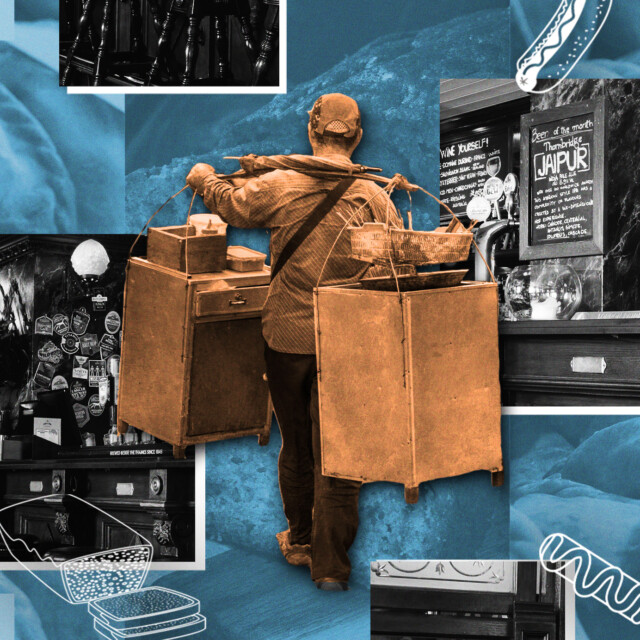This article is a part of our Matters of Taste series, essays from our favorite writers on the artifacts and abstractions they hold most dear in their drinking lives.
When I’m between beers two and three at my favorite sort of bar — that is, of the old, low-lit, neighborhood variety — two things happen. I gain brief, undue confidence in my darts abilities, and I become especially susceptible to purchasing food from roving vendors.
You could easily stick the former in the same category as overconfident drunk dancing. The hubris, much like my darts prowess, usually wears off once I reach the bottom of pint three. However, the latter tendency betrays something deeper: a lifelong fealty to the unique ecosystem of the neighborhood bar. Roving food vendors are a recurring (or maddeningly elusive, depending on your drunken hunger level) feature of such joints, popping by at random to peddle homemade drinking fare like tamales and empanadas.
Coming of age in a big city like Chicago, I always preferred drinking in neighborhood bars, which you may also call taverns, corner bars, beer-and-shot joints, or — if you insist — dives. Their tangible age comforts me, like snuggling under an old quilt. The worn barstools; the shallow dip in the tiles indicating the appointed walking path of countless, faceless patrons; the bric-a-brac obscuring every inch of wall space — they all make me feel part of something larger that’s also wonderfully banal. Some of them indeed endure as historical artifacts; bullet holes dating back to Prohibition puncture scratched wood bar tops and bygone-era cigarette smoke smudges tin-print ceilings. The walls still whisper the gossip spilled long ago by local politicians to the perked ears of journalists.
But what I like best about these old bars is that, theoretically, they represent cities’ last reliably democratic watering holes — where all are welcome and a few bucks is still enough for a cold beer. Historian Bill Savage, a professor of instruction in the Department of English at Chicago’s Northwestern University, writer, and longtime bartender, likens their importance to another imprint of Chicago’s working-class roots, the taqueria or hot dog stand: “It’s the same business model, with tight margins, providing inexpensive and vital things for the neighborhood,” he told me in 2019, fittingly over pints at the Nisei Lounge, one of Wrigleyville’s last remaining joints to fit this description.
In my 20s, I began frequenting a small collection of neighborhood bars on Chicago’s Near Northwest side, which formed part of the weekend route of an Acapulco-born tamale vendor named Claudio Velez, affectionately known to us as The Tamale Guy. Some time between 11 p.m. and 1 a.m., we’d hear Velez’s familiar cries long before we spotted him bearing his trademark red cooler laden with bagged tamales.
“Tamales! Tamales! You want tamales!?” he’d sing cheerfully over the din. “Pork, chicken and cheese, jefe!”
We’d scrape together enough cash for a plastic thank you bag heavy with pork- and cheese-filled tamales, plus extra sides of Velez’s tangy salsa verde, then wolf them down while draining our last, ill-advised round of PBRs. It’s the best sort of drinking food — a hearty masa pocket enveloping chile-braised pork or oozing cheese — forever volcanically hot in its corn husk pouch. Beyond ensuring a far less painful day after, I recall it always being a mutually joyous transaction, and a grateful affirmation of the informal economy. (Velez’s cult following eventually begot a rocky journey to opening his own brick-and-mortar location, The Authentic Tamale Guy. He thankfully hasn’t abandoned roving bar deliveries.)
It’s a transaction I inextricably, fondly associate with my most beloved neighborhood joints. Somehow, it wouldn’t feel right to spot Velez hawking tamales from a cooler at, say, Death & Co. or Dead Rabbit, or any place touting fancy cocktails and upmarket bar snacks. Besides, I can’t think of much else I’d line up to buy from someone rolling in off the street. (Wilted carnations? Thanks, but I’ll say it with cheesy tamales.)
Neighborhood bars seem to defy standard capitalist business models to varying degrees, perhaps because the owner paid off the building long ago or simply doesn’t give a shit. They keep Miller Genuine Draft on inventory for one regular named Bill or Richie who buys it two nights a week on his long-standing “tab.” They install a buzzer and only let in the people they like. They dole out free slabs of the owner’s famous lasagna on open-mic nights during winter.
For the urban dweller, this breed of third place — whose model seems built more to satisfy individual characters than profits — fosters a unique kind of community and an emotional bridge to home. It’s only fitting that the sustenance should take up such homespun forms as cheese balls doled out into paper bowls from a giant plastic tub beneath the back bar, or styrofoam pint containers of Mexican-style shrimp cocktail with packets of saltines purchased from a guy with a cooler (yes, there’s an actual roving shrimp cocktail guy in Mesilla, N.M.).
More than anything, this culinary quirk of American capitalism holds the power to make you feel at home, even if the surroundings are entirely unfamiliar.
Last winter, finding ourselves impulsive new residents of southern New Mexico, my husband and I bellied up after work one day at Palacio Bar, a corner biker joint in tiny Mesilla that’s been open since 1936. Desperately homesick, I was craving just this sort of place — with a popcorn machine, jukebox, and cranky cast of old timers in cowboy hats lording over the corner stools at the long wood bar. Suddenly, a vendor appeared, rolling a little cooler behind him.
“Banana bread?” he asked, smiling at us. “It’s my abuela’s recipe.”
“Yes, please!” I cried at the exact moment my husband said, “No, we’re good.”
I handed over my last, crumpled $5 and cradled my cling-wrapped loaf of sweet bread, still warm and smelling like home.
